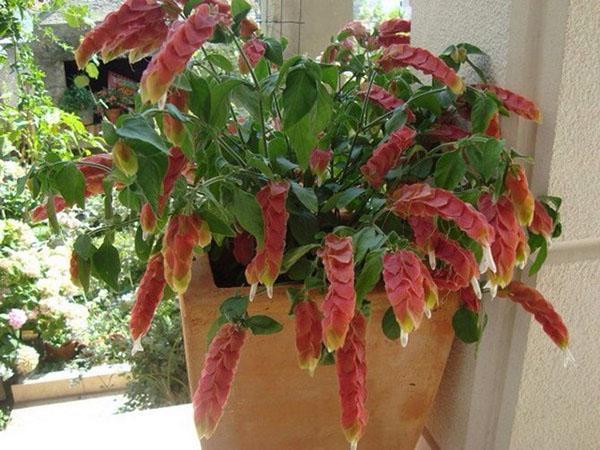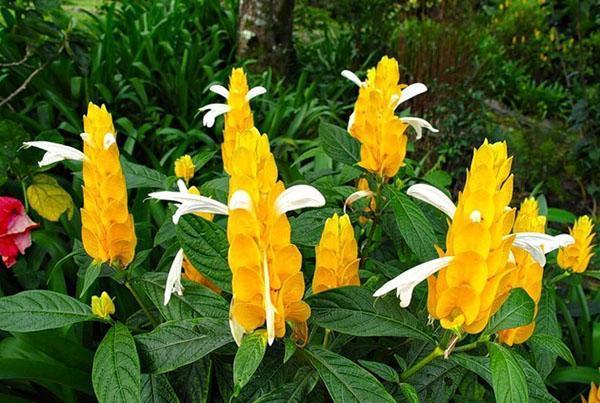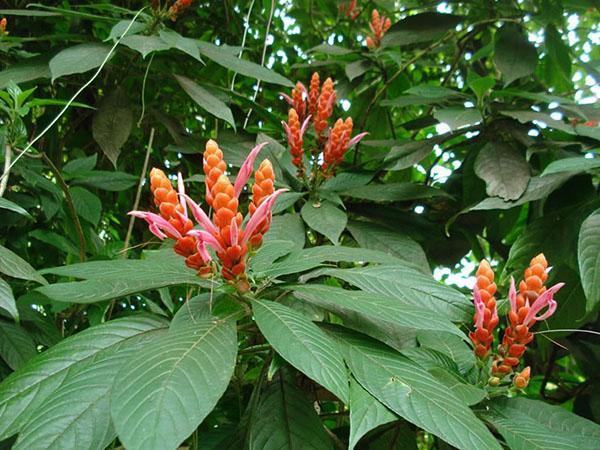Types of pachistachis and features of its cultivation at home
 It is quite simple to grow pachistachis at home, the types of which will be described below. The main thing is to comply with certain conditions and take into account the characteristics of a particular type of plant.
It is quite simple to grow pachistachis at home, the types of which will be described below. The main thing is to comply with certain conditions and take into account the characteristics of a particular type of plant.
Pachistachis is a plant of the Acanthus family, its name literally translates as "thick ear". This unusual and very vibrant evergreen perennial shrub is native to the rainforests of America, the coasts in eastern Australia, and the rainforests in eastern India.
The genus Pachystachis includes approximately 7-17 plant species. But the most popular and suitable for growing at home are the following types:
- pachystachis yellow;
- red pachystachis;
- spikelet pachystachis;
- pachistachis calyptrocalis.
The rest of the species can be found only in the natural habitats of pachistachis, they are not cultivated by humans.
Pachystachis yellow

During the flowering period, namely from early summer to early autumn, large flowers 10-15 cm long, resembling an ear, bloom on yellow pachystachis. Over time, white, cream or slightly yellowish tubular flowers bloom from each bracts located on the spike. Their diameter is only 5 cm.
This is a rather unpretentious type of plant. However, it requires abundant watering and frequent spraying during the hot season. When aphids, mealybugs or whiteflies appear on the trunk and leaves of the plant, treat the pachystachis with an ordinary protective agent.
Red pachistachis
 The homeland of this species is the tropical forests of South America. Pachystachis red, in contrast to the yellow species, has dark green bracts. From them, beautiful and unusual bright red corollas later bloom.
The homeland of this species is the tropical forests of South America. Pachystachis red, in contrast to the yellow species, has dark green bracts. From them, beautiful and unusual bright red corollas later bloom.
The height of the red pachistachis can reach two meters. That is why this type of plant is practically not cultivated at home, but it is excellent for growing in large greenhouses. On the shiny surface of oval dark green leaves, burgundy streaks and stains can sometimes appear. Flowering begins in mid-spring.
Pachystachis spikelet
 This is perhaps the most demanding pachistachis species. That is why it is almost never grown at home, it can be found in greenhouses and botanical gardens.
This is perhaps the most demanding pachistachis species. That is why it is almost never grown at home, it can be found in greenhouses and botanical gardens.
In appearance, Pachystachis spikelet resembles red Pachistachis. In height, it can reach one meter and form a rather dense and lush bush. The bract is completely nondescript dark green, but during the flowering period, bright red corollas are formed on it in large numbers. The shiny emerald-colored leaf blade can reach a length of 25 cm.
Pachystachis calyptrocalis
 This species can reach 2 meters in height, which is why it is rarely found in a house or apartment, most often it is grown in greenhouses. The trunk of the pachystachis calyptrocalis is much narrower than that of other species. The leaves are feathery, oval, opposite, slightly elongated towards the ends. Young leaf blades are colored maroon, which is later replaced by emerald.
This species can reach 2 meters in height, which is why it is rarely found in a house or apartment, most often it is grown in greenhouses. The trunk of the pachystachis calyptrocalis is much narrower than that of other species. The leaves are feathery, oval, opposite, slightly elongated towards the ends. Young leaf blades are colored maroon, which is later replaced by emerald.
Care features
 Despite the relative unpretentiousness of the bush, it still has some care requirements:
Despite the relative unpretentiousness of the bush, it still has some care requirements:
- high humidity;
- sufficient illumination;
- temperature above + 16-20 ° С;
- acidic reaction of the soil;
- good drainage.
Growing pachistachis at home, the types of which were described above, requires certain conditions. The plant belongs to the thermophilic and light-loving tropical species, which prefer rather bright, but diffused light. It is recommended to grow shrubs on the windows of the eastern or northeastern part of the house.
To create conditions as close to natural as possible, the room temperature should be at least + 16 ° C. Lower temperatures will entail abundant shedding of leaves and a long recovery of the plant. In summer, it is recommended to take the plant out to the balcony.
It is preferable to choose the soil for tropical shrubs with acidic reactions and with good air permeability. A layer of expanded clay drainage with a thickness of 2.5-3 cm is also required. For the most comfortable growth, pachistachis requires a flower pot with a volume of at least 2.5-3 liters.
For a tall and spreading crop, it is worth growing one plant in one flowerpot. In order for the pachistachis to look like a lush bush with a large number of inflorescences, it is recommended to plant 3-4 plants in one low flower pot of large diameter
 Since pachistachis belongs to tropical plants, it is especially picky about high soil moisture. It is necessary to regularly water the plant with settled water at room temperature. In winter, watering is reduced to a minimum. And in the hot season, the shrub requires additional spraying.
Since pachistachis belongs to tropical plants, it is especially picky about high soil moisture. It is necessary to regularly water the plant with settled water at room temperature. In winter, watering is reduced to a minimum. And in the hot season, the shrub requires additional spraying.
In the period from early spring to early autumn, the shrub can be fed complex fertilizer twice a month. This will produce a brighter and more abundant bloom.
It is necessary to transplant the plant once a year, in the spring. If the plant has been growing for quite a long time, then once every two to three years is enough. To form a dense and lush bush, you can prune pachystachis. Thanks to this, it will be possible to hide the bare trunk of the plant.
Shrub propagation is carried out with apical petioles in the spring or summer.
As you can see, pachistachis belongs to rather unpretentious, but, nevertheless, plants requiring special conditions. Proper care and adherence to all recommendations will allow you to grow an exotic plant of extraordinary beauty at home!